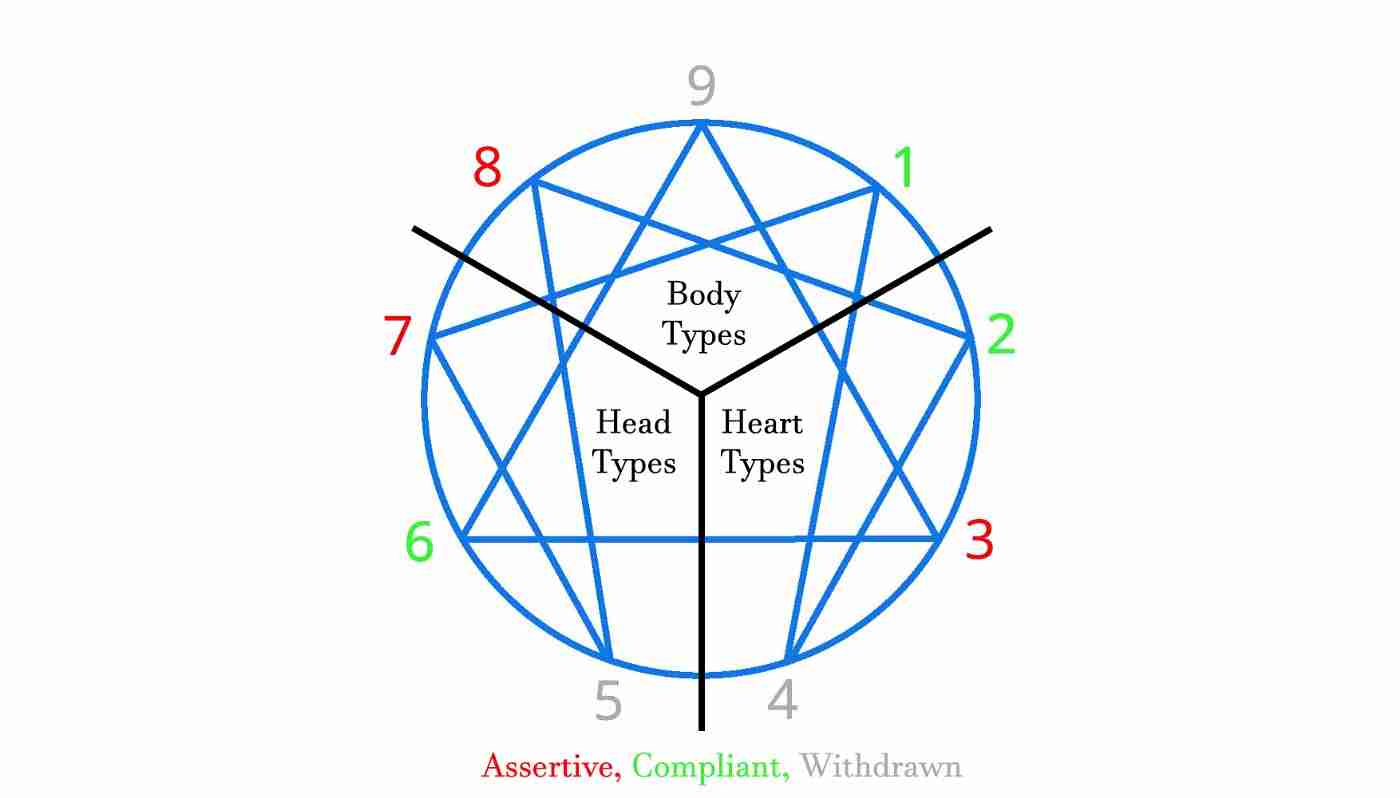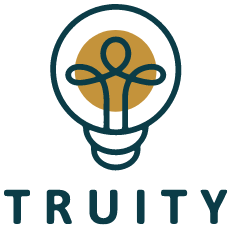The Enneagram personality system can be quite complicated. As if one didn’t have enough on their hands with nine different personality types, we also have to deal with concepts like wings, subtypes, connecting lines, and triads!
However, this comprehensiveness is exactly what makes the Enneagram system such a unique and thorough approach to understanding the human psyche and growing healthily, and few things are more helpful than the Enneagram triads.
If this phrase has you scratching your head, or you’re someone who’s been trying to make sense of relationships around you for a while now, this article is for you! Read on to know what Enneagram triads are, what they mean, and how they can help you.
Enneagram Triads Explained
Also known as the “Centers of Intelligence”, the Enneagram triads are the three distinct sections on the Enneagram diagram that are separated based on the core/dominant emotion that each personality type uses to drive decision-making.
Therefore, we have the Enneagram triads—head, heart, and gut, or more specifically, the Head Triad (Thinking Center), the Heart Triad (Feeling Center), and the Gut Triad (Instinctive Center).
The Head Triad encompasses personality types 5, 6, and 7, while the Gut Triad encompasses 8, 9, and 1, and the Heart Triad encompasses 2, 3, and 4.
Personality types sitting in the Enneagram Head Triad make decisions based on logic, rationale, and practicality—in other words, they use their thoughts. The consequence of this is that they need to deal with fear, usually of the consequences of their decisions.

Those in the Heart Triad make decisions from the heart, which means that they are prone to making decisions based on their feelings and often struggle with a feeling of shame, because of this.

The Gut Triad uses its instincts for decision-making. This triad is given to quick angering.
If you’re not a student of Enneagram studies, you may be wondering why you need to know about the Enneagram triads.
34-year-old Nate’s story should give you a good idea. A type 8 personality, Nate was the personification of confidence, assertiveness, and good leadership, just as most 8s are. However, his decision-making always let him down. The reason?
Nate overthought his decisions, ignored his instincts, and always ruled in favor of the option that would most benefit people. While the latter is a common type 8 trait, it was the former that took a toll on Nate—his decisions never benefitted him in his workplace, though they always helped his colleagues.
Unlike most type 8s who quickly rise in the ranks, Nate was stuck.
If Nate had understood that he should be listening to his gut instead of his head more, his decisions may have benefitted him, too, just as they did Ari, a 29-year-old stockbroker.
Also a type 8, Ari’s decisions were primarily instinct-driven, despite being in a cutthroat world of numbers. And it worked—she’s now rocking Wall Street, having found the perfect mix of listening to her gut and the numbers!
Therefore, understanding the triads can help just about anyone. More specifically, you can reap the following benefits from understanding the Enneagram triads:
- You better understand how each personality type experiences emotions, especially their core emotion, and how they use it to make decisions
- The triads expose decision-making and emotional patterns, which can increase self-awareness and better interpersonal relationships, both personal and professional

- You can better understand why you take certain calls and use this information to improve your decision-making and responses
- You can learn to overcome your core emotion; whether anger, fear, or shame, the core emotion can obstruct good decision-making and instead lead to decisions that hurt you and the people around you, so overcoming these will help in better decision-making
Hillary McCaskey further explains the Triads in this video:
Enneagram Harmonic Triads
Surprise twist—multiple triads exist in the Enneagram system! (Did you really expect such a comprehensive system to be restricted to one triad alone?)
Don Riso and Russ Hudson birthed the idea of the three Harmonic Triads, which group the different personality types into three distinct sets based on how each type reacts to conflict.
Therefore, we have the Positive Outlook Triad (types 2, 7, and 9), the Competency Triad (types 1, 3, and 5), and the Emotional Realness Triad (4, 6, and 8):
- The Positive Outlook Triad: This triad, as the name suggests, loves the glass half full. When faced with conflict, personalities in this triad search for the best possible result instead of getting swept away by the unnecessary details and intricacies of the situation.

This means that they’re able to look at the bigger picture and help others do the same. However, sometimes, this triad’s personalities may avoid even important conflicts, causing the issue at hand to balloon unnecessarily.
- The Competency Triad: This triad solves its conflicts with objectivity. In a conflict with this triad, be prepared for lots of analyzing and logic for conflict resolution!
This typically leads to quick problem resolution, but sometimes, people with this style of conflict resolution can get entangled in unnecessary details, leading to long, often irrelevant discussions that only prolong the issue. - The Emotional Realness Triad: This triad, as the name suggests, loves diving into the issue’s emotional dynamics. The first thing that people in the Emotional Realness Triad do, in conflict, is express their emotions and invite others to express theirs. This helps pave the way for a solution that makes everyone happy.
However, it can also lead to a loop of expressing emotions without arriving at a solution.

The Enneagram conflict triads, as the Harmonic Triad is also known, are excellent conflict resolution tools. Understanding these will help understand the driving factors behind conflicts and reach better resolutions.
It should be noted—the Harmonic Triad is different from the Harmony Groups (the relationist, idealist, and pragmatist groups).
Enneagram Hornevian Triads
Yet another Enneagram grouping, the Enneagram Hornevian Triads are named after celebrated psychoanalyst Dr. Karen Horney, who formulated this grouping based on the satisfaction of one’s own needs via interactions with others.
Though initially not a part of the Enneagram multiverse, the Hornevian model eventually made its entry, seeing as how it was perfectly in line with the former.
In this triad, there is the Compliant Group (personality types 1, 2, and 6), the Assertive Group (3, 7, and 8), and the Withdrawn Group (4, 5, and 9):
- The Compliant Group: This group gravitates towards people with the hope that their needs will be fulfilled (security, attention, and autonomy for types 6, 2, and 1, respectively).
- The Assertive Group: Also referred to as the “Aggressive Group”, this group goes against people to earn what it wants (autonomy, security, and attention for types 8, 7, and 3, respectively).
- The Withdrawn Group: This group, as the name suggests, is withdrawn and tends to move away from people, instead of towards them, to achieve what it wants (autonomy, security, and attention for types 9, 5, and 4, respectively).

Enneagram Stances and Triads
Last but not least, we have the Enneagram triads and stances. A stance, in the Enneagram world, is a method or strategy that helps achieve goals for the different personality types. There are three such stances—the withdrawing (personality types 4, 5, and 9), dependent (1, 2, and 6), and aggressive stances (3, 7, and 8).
- The Aggressive Stance: This is an assertive stance for goal achievement, accompanied by traits such as focus, enthusiasm, high energy, and positivity. However, this behavior can lead to impulsive, ill-thought-out actions that drive away or hurt people.

- The Dependent Stance: This stance relies less on assertiveness and more on relationships for goal achievement. Traits of this stance include empathy, creative problem-solving, and establishing positive relationships, though this may come at the cost of self-sacrifice.
- The Withdrawing Stance: This stance works best on its own. People with this stance are self-aware, smart, insightful, knowledgeable, and curious. However, this desire to be away from people can cause difficulty in forming relationships.
The Final Word
Knowledge of different Enneagram tools, especially the triads, can help you dive deep into understanding your own personality as well as those of others around you, paving the way for healthier and more successful relationships, and ergo, a better life.
The next time you’re having difficulty understanding yourself or someone around you, the triads may have an answer for you!

